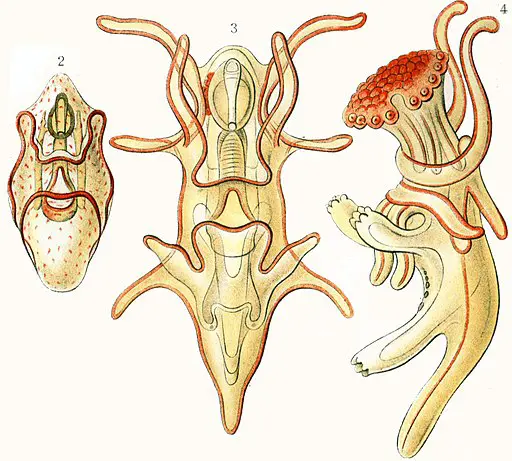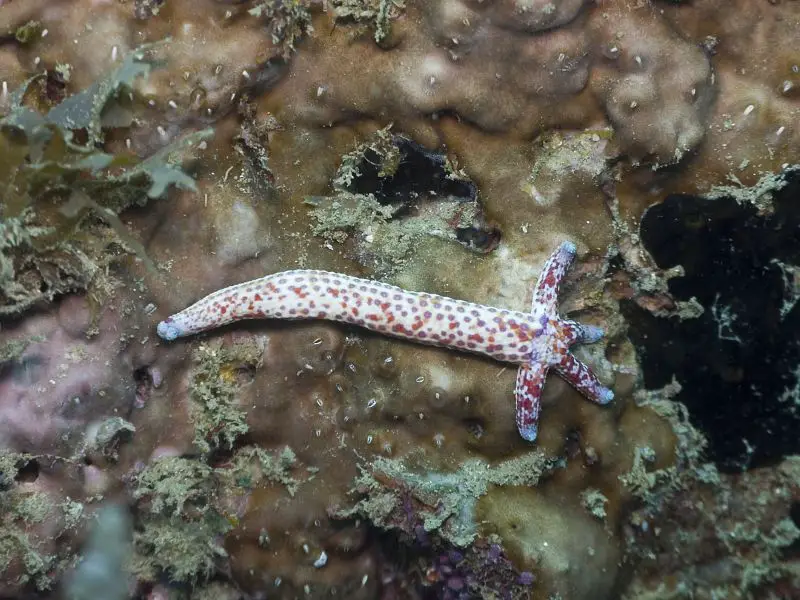Do Starfish Lay Eggs? (Explained)
Starfish, or sea stars, are fascinating marine invertebrates that we often may find on the ocean floor or attached to the rocks. Have you ever wondered about their reproduction process or if they lay eggs? In this post, we’ll talk all about that. However, let’s start with a quick answer:
Most starfish don’t lay eggs but they release them into the water where they float and meet up with the sperm released by males. However, there are a few brooding species that lay their eggs underside of their bodies or on rocks.
However, this certainly doesn’t tell the whole story and in this post, I’ll explain more about how starfish reproduce sexually and asexually. Furthermore, I’ll explain more about species that lay their eggs. Read on!
Starfish sexual reproduction
Most starfish reproduce sexually by releasing their eggs into the seawater. Let’s take a closer look at their life cycle which includes four stages: egg, larvae, juvenile, and adult stages.
Egg stage – sexual reproduction
Most echinoderms, including starfish, sand dollars, sea urchins, sea cucumbers, and crinoids, reproduce through the behavior called broadcast spawning. During this process, several females release their eggs, and several males release their sperm into the water column, all at the same time.
This means that starfish don’t actually lay their eggs, but they release them into the water so that later they float freely and become part of the plankton. However, there are a few exceptions of starfish species, such as the five-armed cushion star, that does lay eggs, which I’ll discuss below.
Sea stars have two gonads in each arm that release gametes (reproductive cells) through an opening called gonopore. With the spawning reproduction method, billions of gametes are spewed into the water, increasing the likelihood that eggs will be successfully fertilized and won’t be eaten immediately by predators on the bottom of the ocean.
Most sea stars reproduce in a discrete and predictable annual cycle, but many complex environmental factors control their reproduction, such as water temperature, light, or the phase of the moon.
Interestingly, the amount of eggs starfish produce can vary depending on the size and species of the sea star. For example, the crown-of-thorns seastar releases millions of small eggs and vast quantities of sperm into the water. However, the smallest starfish produce only a few eggs.
Larval stage
Once eggs are fertilized, they develop into a bilaterally symmetrical (the left and right halves resemble each other) larva called bipinnaria, the first stage of larval development. The bipinnaria is a free-swimming part of the zooplankton covered by cilia (hair-like organelles).
It starts growing arms with the ciliated bands extending into them and developing an anus. These larvae eat suspended food particles and float for about a few days or weeks before transforming to the next larval stage, called brachiolaria.
Brachiolaria is also a feeding larva, and it grows three short, additional arms. It uses arms to test the substratum and provide an initial, temporary grip during settlement. Once it sinks to the bottom and attaches itself, it starts to metamorphose into the adult form.

Interestingly, some brooding species of starfish that we’ll discuss below develop directly into miniature starfish without an intervening larval stage. Some of them develop different larvae types, such as yolky nonfeeding brachiolaria, barrel-shaped larva, or yolky nonbrachiolaria larva.
Juvenile stage
After Brachiolaria settles in suitable habitat, its body develops into a radial symmetry and begins metamorphosing into a miniature sea star. It develops the rest of the organs like the water vascular system, tube feet, eyes, etc.
The juvenile starfish grows very slowly for the next months, mostly hiding under rocks, far from predators. It feeds on suspended food particles and algae. After a few years, sea stars reach sexual maturity and begin spawning. Interestingly, 30% of a star’s body weight is reproductive material when preparing to spawn.
Adulthood stage
Starfish are ready to reproduce and are considered adults once they’re about two years old. Adult sea stars can grow to a diameter even of 40 inches (1 m). However, their size depends on the species, and some can grow only to about 1/2 inch (1.3 cm) like a paddle-spined sea star which is the smallest species.


Most sea star species have five arms, but many have more. For example, the larger species, the sunflower sea star, can grow up to 24 arms. There are about 2,000 species of sea stars that have different sizes and adapted to different environments. You can find them nearly worldwide, primarily in tropical coastal regions.
Read more about where starfish live in my other posts: “Do Starfish Live Under Rocks?”, or “Can Starfish Live In Freshwater?”.
When it comes to the lifespan of the starfish, it isn’t easy to establish it on average because of the species diversity. Additionally, starfish don’t have characteristic features determining their age, such as growth rings or a predictable correlation between size and age.
Some studies estimated that starfish could live 35 years on average, and you can read more about it in my other blog post: “How Long Do Starfish Live?”.
Starfish can live pretty long because they don’t have a lot of predators, and on top of that, they can regrow their limbs or regrow an entirely new body from a single arm. This availability is considered an asexual reproduction.
Asexual reproduction
One of the fascinating things about starfish is that they can clone themselves! Some starfish species can reproduce asexually by fission of their bodies and others by autotomy of one or more of their arms.
Fission occurs when the animal splits its body into two parts. Next, each half regenerates into a new and complete individual. The division takes place either across the sea stars’ central disc or at the base of the arm.
Some species, such as Linckia multifora, have even more remarkable regenerative capabilities and can reproduce by autotomy of arms. This means they can grow a complete individual from just a single arm, forming comet-like shapes.

Asexual reproduction is often a response to predators, so they are a less obvious target.
Starfish that lay eggs
As I mentioned earlier, a few starfish species lay eggs, which makes them brooding species. These animals have male and female genitals in one body, called hermaphrodites, and can fertilize their own eggs.
These certain sea star species either envelop their eggs or hold them in specialized structures. For instance, the fived-armed cushion star (Parvulastra exigua) deposits eggs in sticky masses on rocks of coastal reefs and tide pools. In this case, baby starfish complete their development on their own.
Other species care for their young throughout their whole development, such as Anasterias sea star that holds its eggs around its mouth, located underside of its body, while they develop. Other species, like Smilasterias multipara, incubates their eggs in its stomach.
These brooding species use their tube feet to pick up and transform released eggs to their mouths. Consequently, these adult sea stars don’t feed themselves until approximately a month later, when the young disappear.
What’s more, in these species, the eggs are larger and supplied with the yolk. They generally develop directly into tiny starfish without a larval stage. Interestingly, brooding is especially common in polar and deep-sea species that live in difficult environments for larval development or in smaller species that produce just a few eggs.
Resources
- Larry R McEdward and Benjamin G Miner. Larval and life-cycle patterns in echinoderms. Canadian Journal of Zoology. 79(7): 1125-1170. https://doi.org/10.1139/z00-218
- In Byrne, M., In O’Hara, T. D., CSIRO (Australia),, & Australian Biological Resources Study,. (2017). Australian echinoderms: Biology, ecology and evolution.
- Image “Starfish Shedding Eggs” by Steve Childs
You may also like:

Welcome to Bubbly Diver!
I’m glad to see you here. This blog is created for all marine creature lovers by a bubbly diver - me, Dori :)


